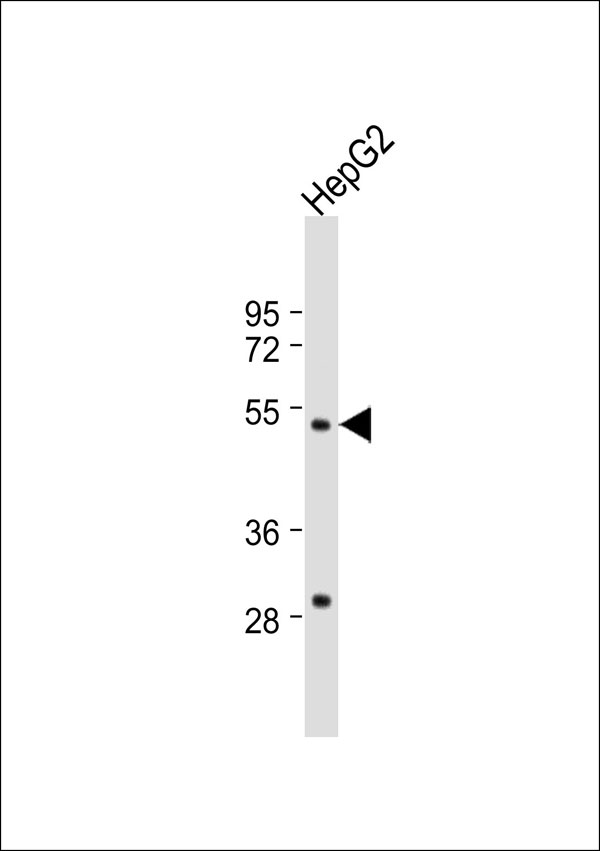ZFP36L2 Antibody
Purified Rabbit Polyclonal Antibody (Pab)
- SPECIFICATION
- CITATIONS
- PROTOCOLS
- BACKGROUND

Application
| WB |
|---|---|
| Primary Accession | P47974 |
| Reactivity | Human |
| Host | Rabbit |
| Clonality | Polyclonal |
| Calculated MW | 51 KDa |
| Antigen Region | 221-270 aa |
| Gene ID | 678 |
|---|---|
| Target/Specificity | KLH-conjugated synthetic peptide encompassing a sequence within the center region of human ZFP36L2. The exact sequence is proprietary. |
| Dilution | WB~~ 1:1000 |
| Format | Rabbit IgG in phosphate buffered saline , pH 7.4, 150mM NaCl, 0.09% (W/V) sodium azide and 50% glycerol |
| Storage | Store at -20 °C.Stable for 12 months from date of receipt |
| Name | ZFP36L2 (HGNC:1108) |
|---|---|
| Function | Zinc-finger RNA-binding protein that destabilizes several cytoplasmic AU-rich element (ARE)-containing mRNA transcripts by promoting their poly(A) tail removal or deadenylation, and hence provide a mechanism for attenuating protein synthesis (PubMed:14981510, PubMed:25106868, PubMed:34611029). Acts as a 3'-untranslated region (UTR) ARE mRNA-binding adapter protein to communicate signaling events to the mRNA decay machinery (PubMed:25106868). Functions by recruiting the CCR4-NOT deadenylase complex and probably other components of the cytoplasmic RNA decay machinery to the bound ARE-containing mRNAs, and hence promotes ARE-mediated mRNA deadenylation and decay processes (PubMed:25106868). Binds to 3'-UTR ARE of numerous mRNAs (PubMed:14981510, PubMed:20506496, PubMed:25106868). Promotes ARE- containing mRNA decay of the low-density lipoprotein (LDL) receptor (LDLR) mRNA in response to phorbol 12-myristate 13-acetate (PMA) treatment in a p38 MAPK-dependent manner (PubMed:25106868). Positively regulates early adipogenesis by promoting ARE-mediated mRNA decay of immediate early genes (IEGs). Plays a role in mature peripheral neuron integrity by promoting ARE-containing mRNA decay of the transcriptional repressor REST mRNA. Plays a role in ovulation and oocyte meiotic maturation by promoting ARE-mediated mRNA decay of the luteinizing hormone receptor LHCGR mRNA. Acts as a negative regulator of erythroid cell differentiation: promotes glucocorticoid-induced self-renewal of erythroid cells by binding mRNAs that are induced or highly expressed during terminal erythroid differentiation and promotes their degradation, preventing erythroid cell differentiation. In association with ZFP36L1 maintains quiescence on developing B lymphocytes by promoting ARE-mediated decay of several mRNAs encoding cell cycle regulators that help B cells progress through the cell cycle, and hence ensuring accurate variable-diversity-joining (VDJ) recombination process and functional immune cell formation. Together with ZFP36L1 is also necessary for thymocyte development and prevention of T-cell acute lymphoblastic leukemia (T-ALL) transformation by promoting ARE-mediated mRNA decay of the oncogenic transcription factor NOTCH1 mRNA. |
| Cellular Location | Nucleus. Cytoplasm. Note=Shuttles between the nucleus and the cytoplasm in a XPO1/CRM1-dependent manner {ECO:0000250|UniProtKB:P23949} |
| Tissue Location | Expressed mainly in the basal epidermal layer, weakly in the suprabasal epidermal layers (PubMed:27182009). Expressed in epidermal keratinocytes (at protein level) (PubMed:27182009) Expressed in oocytes (PubMed:34611029). |

Thousands of laboratories across the world have published research that depended on the performance of antibodies from Abcepta to advance their research. Check out links to articles that cite our products in major peer-reviewed journals, organized by research category.
info@abcepta.com, and receive a free "I Love Antibodies" mug.
Provided below are standard protocols that you may find useful for product applications.
Background
mRNA-binding protein that plays a key role in self- renewal of erythroid cells in response to glucocorticoids. Specifically binds to the AU-rich element (ARE) in the 3'-UTR of target mRNAs, promoting their deadenylation and degradation (PubMed:14981510). Specifically expressed in burst-forming unit- erythroid (BFU-E) progenitors in response to glucocorticoids and acts as a negative regulator of erythroid cell differentiation: promotes self-renewal of erythroid cells by binding mRNAs that are induced or highly expressed during terminal erythroid differentiation and promotes their degradation, preventing erythroid cell differentiation. Down-regulated during erythroid differentiation from the BFU-E stage, stabilizing mRNAs required for terminal differentiation (By similarity).
References
Ino T.,et al.Oncogene 11:2705-2710(1995).
Nie X.F.,et al.Gene 152:285-286(1995).
Hillier L.W.,et al.Nature 434:724-731(2005).
Mural R.J.,et al.Submitted (JUL-2005) to the EMBL/GenBank/DDBJ databases.
Dephoure N.,et al.Proc. Natl. Acad. Sci. U.S.A. 105:10762-10767(2008).
If you have used an Abcepta product and would like to share how it has performed, please click on the "Submit Review" button and provide the requested information. Our staff will examine and post your review and contact you if needed.
If you have any additional inquiries please email technical services at tech@abcepta.com.













 Foundational characteristics of cancer include proliferation, angiogenesis, migration, evasion of apoptosis, and cellular immortality. Find key markers for these cellular processes and antibodies to detect them.
Foundational characteristics of cancer include proliferation, angiogenesis, migration, evasion of apoptosis, and cellular immortality. Find key markers for these cellular processes and antibodies to detect them. The SUMOplot™ Analysis Program predicts and scores sumoylation sites in your protein. SUMOylation is a post-translational modification involved in various cellular processes, such as nuclear-cytosolic transport, transcriptional regulation, apoptosis, protein stability, response to stress, and progression through the cell cycle.
The SUMOplot™ Analysis Program predicts and scores sumoylation sites in your protein. SUMOylation is a post-translational modification involved in various cellular processes, such as nuclear-cytosolic transport, transcriptional regulation, apoptosis, protein stability, response to stress, and progression through the cell cycle. The Autophagy Receptor Motif Plotter predicts and scores autophagy receptor binding sites in your protein. Identifying proteins connected to this pathway is critical to understanding the role of autophagy in physiological as well as pathological processes such as development, differentiation, neurodegenerative diseases, stress, infection, and cancer.
The Autophagy Receptor Motif Plotter predicts and scores autophagy receptor binding sites in your protein. Identifying proteins connected to this pathway is critical to understanding the role of autophagy in physiological as well as pathological processes such as development, differentiation, neurodegenerative diseases, stress, infection, and cancer.


